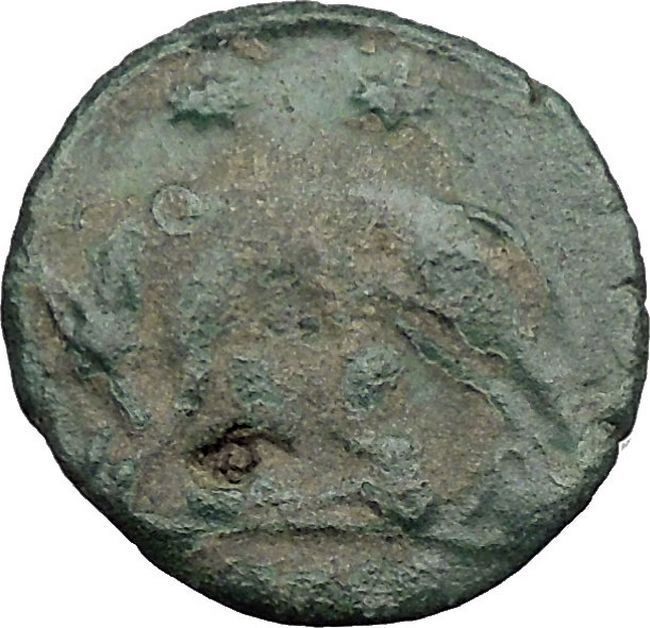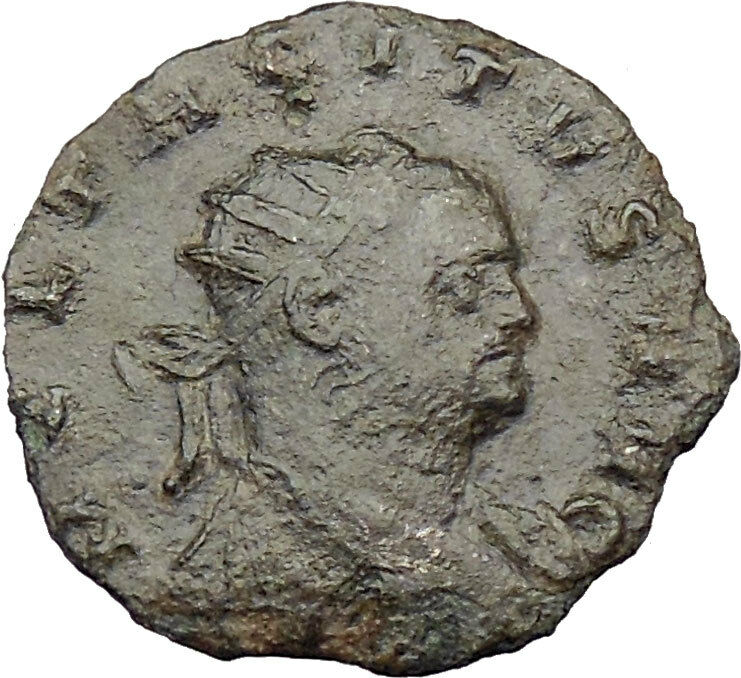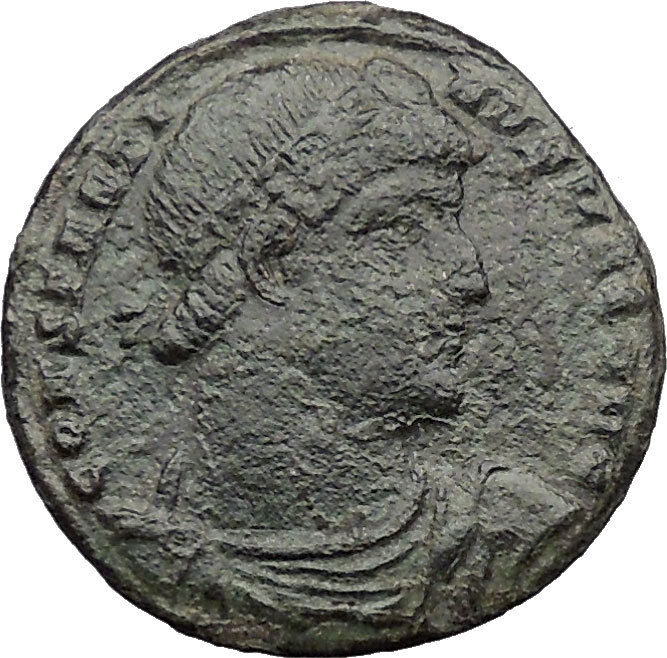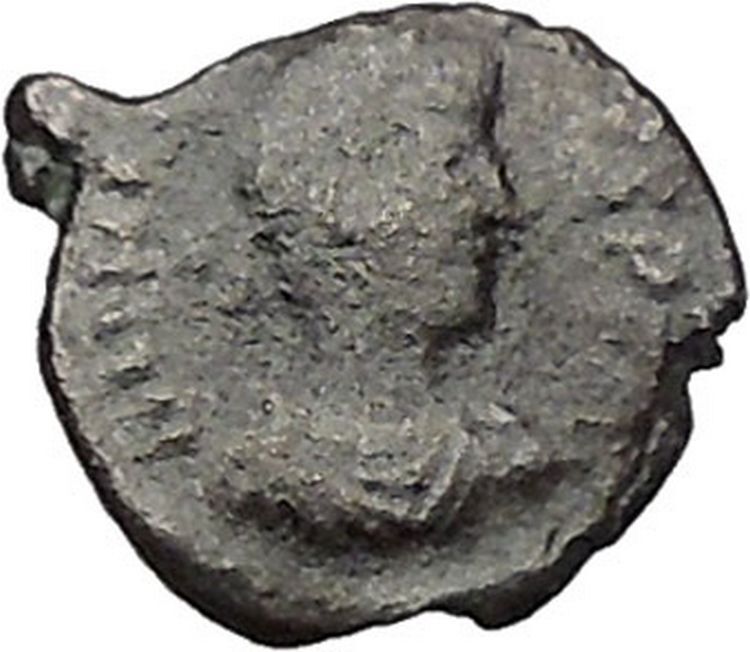|
Arcadius – Roman Emperor: 383-408 A.D.
Bronze AE2 22mm (4.60 grams) Antioch mint, struck 392-395 A.D.
Reference: RIC 68c
D N ARCADIVS P F AVG, pearl-diademed, draped and cuirassed bust right.
GLORIA ROMANORVM / ANTB, Emperor standing facing head right, holding standard (vexillum) and globe.
You are bidding on the exact item pictured, provided with a Certificate of Authenticity and Lifetime Guarantee of Authenticity.
 The vexillum was a flag-like object used as a military standard by units in the Ancient Roman army. The vexillum was a flag-like object used as a military standard by units in the Ancient Roman army.
The word vexillum is a diminutive of the Latin word, velum, meaning a sail, which confirms the historical evidence (from coins and sculpture) that vexilla were literally “little sails”: flag-like standards. In the vexillum, the cloth was draped from a horizontal crossbar suspended from the staff. That is unlike most modern flags in which the ‘hoist’ of the cloth is attached directly to the vertical staff. The bearer of a vexillum was known as a vexillarius or vexillifer.
Just as in the case of the regimental colors or flag of Early Modern Western regiments, the vexillum was a treasured symbol of the military unit that it represented and it was closely defended in combat. It was the main standard of some types of unit, especially cavalry; however, it was regarded as less important than a legion’s aquila, or eagle, and may have represented a subdivision of a legion. However, that is not entirely clear from surviving sources (see vexillatio).
The only existent Roman military vexillum is dated to the first half of the 3rd century AD and is housed in the Pushkin Museum of Fine Arts. It is an almost square piece of coarse linen cloth with the image of the goddess Victoria and measures 47×50 cm. The lower edge has remains of a fringe. The vexillum was once attached to a piece of reed wood. It is unknown to which military unit the vexillum belonged. The vexillum was found in Egypt shortly before 1911, but its exact provenance is also unclear.
Each tactical unit in the imperial army, from centuria upwards, had its own standard. This consisted of a pole with a variety of adornments that was borne by dedicated standard-bearers who normally held the rank of duplicarius. Military standards had the practical use of communicating to unit members where the main body of the unit was situated, so that they would not be separated, in the same way that modern tour-group guides use umbrellas or flags. But military standards were also invested with a mystical quality, representing the divine spirit (genius) of the unit and were revered as such (soldiers frequently prayed before their standards). The loss of a unit’s standard to the enemy was considered a terrible stain on the unit’s honour, which could only be fully expunged by its recovery.
The standard of a centuria was known as a signum, which was borne by the unit’s signifer. It consisted of a pole topped by either an open palm of a human hand or by a spear-head. The open palm, it has been suggested, originated as a symbol of the maniple (manipulus=”handful”), the smallest tactical unit in the Roman army of the mid-Republic. The poles were adorned with two to six silver discs (the significance of which is uncertain). In addition, the pole would be adorned by a variety of cross-pieces (including, at bottom, a crescent-moon symbol and a tassel). The standard would also normally sport a cross-bar with tassels.
The standard of a Praetorian cohort or an auxiliary cohort or ala was known as a vexillum or banner. This was a square flag, normally red in colour, hanging from a crossbar on the top of the pole. Stitched on the flag would be the name of the unit and/or an image of a god. An exemplar found in Egypt bears an image of the goddess Victory on a red background. The vexillum was borne by a vexillarius. A legionary detachment (vexillatio) would also have its own vexillum. Finally, a vexillum traditionally marked the commander’s position on the battlefield. The exception to the red colour appears to have been the Praetorian Guard, whose vexilla, similar to their clothing, favoured a blue background.
From the time of Marius (consul 107 BC), the standard of all legions was the aquila (“eagle”). The pole was surmounted by a sculpted eagle of solid gold, or at least gold-plated silver, carrying thunderbolts in its claws (representing Jupiter, the highest Roman god. Otherwise the pole was unadorned. No exemplar of a legionary eagle has ever been found (doubtless because any found in later centuries were melted down for their gold content). The eagle was borne by the aquilifer, the legion’s most senior standard-bearer. So important were legionary eagles as symbols of Roman military prestige and power, that the imperial government would go to extraordinary lengths to recover those captured by the enemy. This would include launching full-scale invasions of the enemy’s territory, sometimes decades after the eagles had been lost e.g. the expedition in 28 BC by Marcus Licinius Crassus against Genucla (Isaccea, near modern Tulcea, Rom., in the Danube delta region), a fortress of the Getae, to recover standards lost 33 years earlier by Gaius Antonius, an earlier proconsul of Macedonia. Or the campaigns of AD 14-17 to recover the three eagles lost by Varus in AD 6 in the Teutoburg Forest.
Under Augustus, it became the practice for legions to carry portraits (imagines) of the ruling emperor and his immediate family members. An imago was usually a bronze bust carried on top of a pole like a standard by an imaginifer.
From around the time of Hadrian (r. 117-38), some auxiliary alae adopted the dragon-standard (draco) commonly carried by Sarmatian cavalry squadrons. This was a long cloth wind-sock attached to an ornate sculpture of an open dragon’s mouth. When the bearer (draconarius) was galloping, it would make a strong hissing-sound.
 Arcadius (Latin: Flavius Arcadius Augustus; Greek: Ἀρκάδιος; 1 January 377 – 1 May 408) was Byzantine Emperor from 383 to 408. He was the eldest son of Theodosius I and his first wife Aelia Flaccilla, and brother of the Western Emperor Honorius. A weak ruler, his reign was dominated by a series of powerful ministers and by his wife, Aelia Eudoxia. Arcadius (Latin: Flavius Arcadius Augustus; Greek: Ἀρκάδιος; 1 January 377 – 1 May 408) was Byzantine Emperor from 383 to 408. He was the eldest son of Theodosius I and his first wife Aelia Flaccilla, and brother of the Western Emperor Honorius. A weak ruler, his reign was dominated by a series of powerful ministers and by his wife, Aelia Eudoxia.
Arcadius was born in Hispania, the elder son of Theodosius I and Aelia Flaccilla, and brother of Honorius, who would become a Western Roman Emperor. His father declared him an Augustus and co-ruler for the Eastern half of the Empire in January 383. His younger brother was also declared Augustus in 393, for the Western half.
As emperors, Honorius was under the control of the Romanized Vandal magister militum Flavius Stilicho while Arcadius was dominated by one of his ministers, Rufinus. Stilicho is alleged by some to have wanted control of both Emperors, and is supposed to have had Rufinus assassinated by Gothic mercenaries in 395; though definite proof of Stilicho’s involvement in the assassination is lacking, the intense competition and political jealousies engendered by the two figures compose the main thread of the first part of Arcadius’ reign. Arcadius’ new advisor, the eunuch Eutropius, simply took Rufinus’ place as the power behind the Eastern imperial throne.
Arcadius was also dominated by his wife Aelia Eudoxia, who convinced her husband to dismiss Eutropius, who was holding the consulate, at the height of his power, in 399. That same year, on 13 July, Arcadius issued an edict ordering that all remaining non-Christian temples should be immediately demolished.
Eudoxia’s influence was strongly opposed by John Chrysostom, the Patriarch of Constantinople, who felt that she had used her family’s wealth to gain control over the Emperor. Eudoxia used her influence to have Chrysostom deposed in 404, but she died later that year. Eudoxia gave to Arcadius four children: three daughters, Pulcheria, Arcadia and Marina, and one son, Theodosius, the future Emperor Theodosius II.
Arcadius was dominated for the rest of his rule by Anthemius, the Praetorian Prefect, who made peace with Stilicho in the West. Arcadius himself was more concerned with appearing to be a pious Christian than he was with political or military matters, and he died, only nominally in control of his Empire, in 408.
Character and works
In this reign of a weak Emperor dominated by court politics, a major theme was the ambivalence felt by prominent individuals and the court parties that formed and regrouped round them towards barbarians, which in Constantinople at this period meant Goths. In the well-documented episode that revolved around Gainas, a number of Gothic foederati stationed in the capital were massacred, the survivors fleeing under the command of Gainas to Thrace, where they were tracked down by imperial troops and slaughtered and Gainas dispatched. The episode has been traditionally interpreted as a paroxysm of anti-barbarian reaction that served to stabilize the East. The main source for the affair is a mythology à clef by Synesius of Cyrene, Aegyptus sive de providentia, (400) an Egyptianising allegory that embodies a covert account of the events, the exact interpretation of which continues to baffle scholars. Synesius’ De regno, which claims to be addressed to Arcadius himself, contains a tirade against Goths.
A new forum was built in the name of Arcadius, on the seventh hill of Constantinople, the Xērolophos, in which a column was begun to commemorate his ‘victory’ over Gainas (although the column was only completed after Arcadius’ death by Theodosius II).
The Pentelic marble portrait head of Arcadius (now in the Istanbul Archaeology Museum) was discovered in Istanbul close to the Forum Tauri, in June 1949, in excavating foundations for new buildings of the University at Beyazit. The neck was designed to be inserted in a torso, but no statue, base or inscription was found. The diadem is a fillet with rows of pearls along its edges and a rectangular stone set about with pearls over the young Emperor’s forehead.
|





 The vexillum was a flag-like object used as a military standard by units in the Ancient Roman army.
The vexillum was a flag-like object used as a military standard by units in the Ancient Roman army. Arcadius (Latin: Flavius Arcadius Augustus; Greek: Ἀρκάδιος; 1 January 377 – 1 May 408) was Byzantine Emperor from 383 to 408. He was the eldest son of Theodosius I and his first wife Aelia Flaccilla, and brother of the Western Emperor Honorius. A weak ruler, his reign was dominated by a series of powerful ministers and by his wife, Aelia Eudoxia.
Arcadius (Latin: Flavius Arcadius Augustus; Greek: Ἀρκάδιος; 1 January 377 – 1 May 408) was Byzantine Emperor from 383 to 408. He was the eldest son of Theodosius I and his first wife Aelia Flaccilla, and brother of the Western Emperor Honorius. A weak ruler, his reign was dominated by a series of powerful ministers and by his wife, Aelia Eudoxia.




